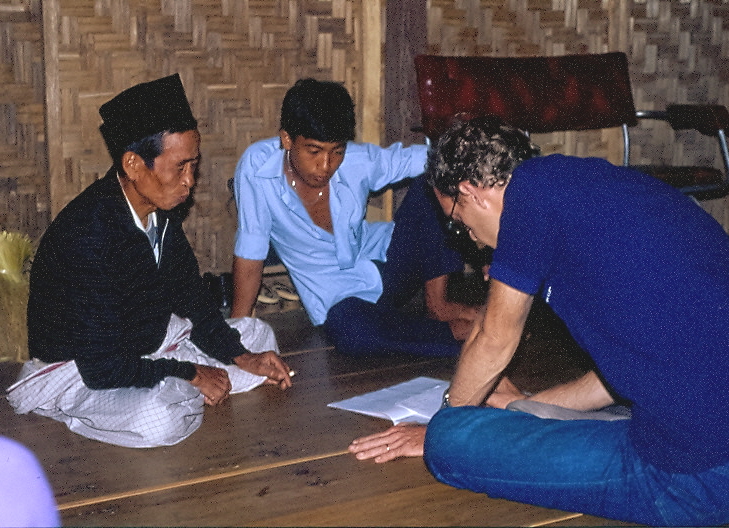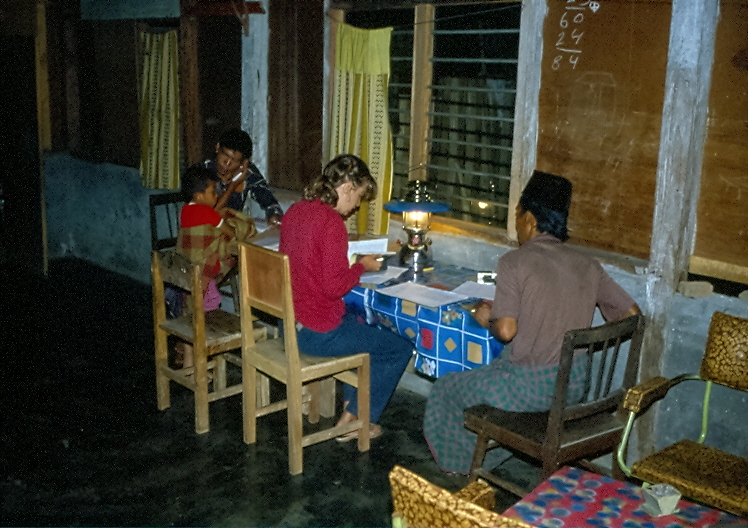Methods: Recording Formats and Strategies
As a general rule, it is important to distinguish when preparing fieldnotes between what was observed (seen and heard) and what was asked. That is, which information the ethnographer gathered from a social situation without their own intervention by simply watching and listening, and which information was obtained by asking questions.
Furthermore, it is always necessary to record, in addition to the date and location, which individuals were involved in the respective event and how the ethnographer was positioned within the event. The latter is important to assess to what extent the situation was influenced by their own behavior. Guidance on creating fieldnotes can be found in most methodological handbooks (e.g., deWalt & deWalt, 2011; Beer & König, 2020).


In the past, social and cultural anthropologists primarily recorded their notes using pen, paper, and, at most, mechanical typewriters. Today, they have access to entirely different technical possibilities, including lightweight, portable laptops (which can also be powered by solar energy), smartphones, digital pens with recording functions, voice recognition software, mapping programs, and more. For instance, scratchnotes can be captured using a digital pen, daily logs can be directly typed (or spoken) into a computer, and – provided there are suitable network connections – secured in a cloud. However, it should be noted that files stored in a cloud are not entirely secure from external access (see articles on Data Storage and Data Security). Every activity on the internet leaves a trace, which is why it is strongly advised against storing field notes in clouds, even those provided by one’s own university. Instead, external hard drives and USB sticks should be used.
Depending on circumstances, a laptop may not always be the ideal tool – due to weather conditions, for example, or because such a device might attract undue attention. (There are numerous accounts of laptops becoming filled with sand, overheating in the sun, becoming too damp during rainy seasons, or being stolen.) In such cases, pen and paper or a classic travel typewriter may be more suitable.
It is also not advisable to rely exclusively on verbal recordings for field notes, such as speaking into a recording device and saving the result as an audio file. This approach omits an important step of reflection: the significantly more time-intensive process of typing or handwriting notes facilitates deeper cognitive engagement,pausing, sorting, and searching for appropriate formulations. This ensures that the recorded information is better retained in memory, while also revealing ambiguities, which can be crucial for further fieldwork. According to neuroscientific studies, handwriting is superior to typing in this regard, due to the spatial dimension of writing on paper (e.g., Mueller & Oppenheimer, 2014).
Systematic and Standardized Data Collection
These daily research protocols or fieldnotes are just one element of the recording formats that ethnographers use, depending on the methods they apply. However, it is important to understand that they are an absolute necessity and form the core of ethnographic work, even though other recording formats are also employed, not all of which are written. For example, written fieldnotes also play a central role in videographic research projects (e.g., Wetzels, 2021) or PhotoVoice studies (e.g., Röttger-Rössler & Seise, 2023; Röttger-Rössler et al., 2019), as they provide important information about the social context, specific events, and the researcher’s position. We can only briefly point to the methodological challenges associated with audio-visual survey methods here (e.g., Tuma et al., 2013). Special research situations also include online ethnographies, which are addressed separately in the article Online Ethnography.
Within the framework of classic participant observation, social and cultural anthropologists employ numerous other methods depending on the research question, many of which are quantitative in nature, such as demographic surveys, household surveysA household survey is an overview study conducted through standardized surveys of a representative sample or random sample of households within a study region (see: Survey/Survey Data). In social and cultural anthropology, the terms survey, household survey, and census are often used interchangeably. Read More, linguistic surveys, measurements of field sizes and harvest yields, or systematic observations like time allocation studiesA time allocation study systematically measures the amount of time individuals spend on specific tasks and activities. These studies examine how people budget their time in various social and cultural contexts. For example, they explore how the division of labor in productive and reproductive activities is organized across genders and generations: How much time per day do mothers, fathers, older siblings, grandparents, and others spend caring for young children? How much time is allocated by whom to economic activities, caregiving tasks, or neighborhood interactions? Various methods are used to measure time budgeting, generating quantitative and replicable datasets. Read More. Each of these specific methods involves particular modes of documentation, which must always be sensitively adapted to the respective cultural context and research conditions.
Literature
Beer, B. & König, A. (Eds.).( 2020). Methoden ethnologischer Feldforschung. Ethnologische Paperbacks. (3rd ed.). Dietrich Reimer Verlag.
DeWalt, K. M. & DeWalt, B. R. (2011). Participant Observation: A Guide for Fieldworkers. Lanham, Md: Rowman & Littlefield.
Mueller, P. A., & Oppenheimer, D. M. (2014). The pen is mightier than the keyboard: Advantages of longhand over laptop note taking. Psychological Science, 25, 1159–1168. https://doi.org/10.1177/0956797614524581
Röttger-Rössler, B. & Seise, F. (2023). Tangible pasts: Memory practices among children and adolescents in Germany, an affect-theoretical approach. In Ethos 51 1–96-110. https://doi.org/10.1111/etho.12377
Röttger-Rössler, B., Scheidecker, G. & Lam A. T. A. (2019). Narrating visualized feelings: Photovoice as a tool for researching affects and emotions among school students. In Analyzing Affective Societies. Methods and Methodologies. (p. 78-97). London, New York: Routledge Studies in Affective Societies. https://doi.org/10.4324/9780429424366
Tuma, R.; Schnettler, B. & Knoblauch, H. (2013). Videographie. Einführung in die interpretative Videoanalyse sozialer Situationen. Wiesbaden. Springer. https://doi.org/10.1007/978-3-531-18732-7
Wetzels, M. (2021). Affektdramaturgien im Fußballsport. Die Entzauberung kollektiver Emotionen aus wissenssoziologischer Perspektive. Bielefeld: transcript Verlag. https://doi.org/10.1515/9783839455081

